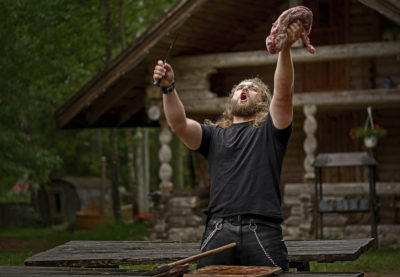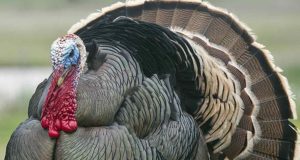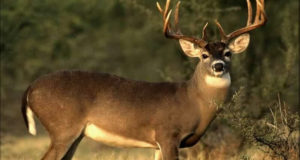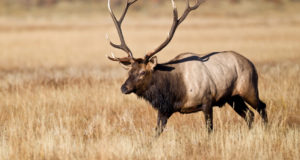|
Listen To The Article
|

When it comes to surviving in the wild, a quality small game snare strategy is essential for getting the food that you need.
The typical bug out bag has a measly three days worth of food in it, a figure that has always bothered me. I mean, does anyone really think they’re going to get to safety in three days if they have to walk? I sure don’t. With an average walking speed of 3 miles per hour, 12 hours of walking per day would yield just about 100 miles in three days. That’s still not far enough to get out of the path of a hurricane.
Redundancy Is Crucial For An Effective Survival Food Supply
This leaves us all with a pressing question. What do we do in order to increase the range we can get out of our bug out bags? Basically, the answer boils down to the following:
- Loading more food in the bag, making it heavier
- Having a cache of more food somewhere that you’re sure you can get to
- Finding more food along the way
I’d say the right answer to that is… all three. There’s no way that any of us can be sure that things are going to go according to our plans. With that in mind, we had better stack the deck in our favor. That means redundancy, especially when it comes to our critical supplies.
Personally, I carry a five-day food supply in my bug out bag, albeit light rations for those five days. Nevertheless, I’ve got sufficient fat content on my body. As long as I’m eating, I’m going to be all right. For that matter, walking off a few pounds would probably do me some good.
I’ve also got a food cache set up about 120 miles from my home in a buried five-gallon bucket. That has another five days worth of food in it. I could have put it closer, but if I end up going one day without food, it’s not going to kill me. Putting it at 120 miles means I should reach it after four days of walking. Obviously, I’m assuming here that I don’t get hurt along the way.
A Good Small Game Snare Strategy For When You Desperately Need Food
That leaves the prospect of coming up with more food during the journey. For me, like many others, that means hunting and fishing more than anything else. While I carry a guide to edible plants in my bug out bag and will try to make good use of it, I’m still your basic carnivore. So, I’m going to want something to eat besides dandelions or cactuses, although I’ll eat them if I find them.
Many of us think in terms of hunting for big game when it comes to finding something to eat out in the wild. That’s perfectly understandable, of course. After all, a nice haunch of venison sounds a whole lot more appetizing and satisfying than roasting squirrel over the fire like a hot dog. But the chances of finding a squirrel are a lot higher than that of finding a deer. This reality is attested to by how many hunters come home without getting anything. Consequently, if you want to eat rather than get a trophy to hang on the wall, squirrel might just be on the menu.
Squirrels Are Perfect For Putting Your Small Game Snare Strategy To Use
Squirrel are plentiful, breed quickly, and are available in just about any part of the country as long as there are trees. That makes them a bit scarce in the Southwest and probably in the middle of the Midwestern farmlands. But even then, there are patches of forest which will house a population of squirrels.
The trick then becomes, how do you catch those squirrels? You don’t want to shoot them, not even with a .22, because they aren’t very big. Not only is it going to be hard to hit them, but if you do, you might spoil some of the meat. It would be much better to catch them with some sort of snare, thereby keeping the meat fresh and usable.
This task is actually much easier than you might imagine. A key to any sort of trap or snare is to put it where animals are likely to go. For squirrels, who spend much of their lives in trees, that means either in a tree or on the way up into the tree. The second method is better as it’s easier to accomplish.
The Ideal Small Game Snare Strategy: Thinking Like A Squirrel
Now here’s something that most people don’t know about squirrels. They will always seek the easiest way up into a tree. Yes, their paths seem random to us, but they’re pretty astute in picking their course of action. They’re also a bit on the lazy side like us, so they’ll take an easier way if it offers itself.
For this reason, let’s use that principle to our advantage. Start by leaning a broken off branch up against a tree trunk or lower branch to create an easier way up. You need something that’s three to four inches in diameter. Then, we’ll put the snare on that path so we can catch our squirrel. Actually, it’s better to put several of them on there so we can catch several squirrels. Squirrel number two isn’t going to avoid that easy path simply because they see squirrel number one hanging there dead. They’re not quite that smart.
Sound Snare Wire Is A Critical Component Of Your Small Game Snare Strategy
To make the snare itself, you need some snare wire. I like using steel guitar strings for this because they are strong and lightweight. Furthermore, they don’t kink easily and they already have a loop on one end. That loop allows me to create a noose effortlessly. I add a loop to the other end in my workshop so that I have something to anchor the snare with. In addition, this procedure will keep the squirrels from running off with my snare wire.
The loop of the snare (or noose) needs to sit on the top side of the ramp that you’ve created. If so, the squirrel will run up the branch and their head will go into the loop, which will pull it tight. That will cause them to fall off the branch and hang by their neck until dead.
Use Multiple Snares As Part Of Your Small Game Snare Strategy
Three or four snares on the same pole will allow you to catch three or four squirrels unless one of them happens to be named MacGyver. If they are, then I’d keep your eyes open to make sure that they don’t turn your snares into a trap for you. However, you’ll be able to tell that easily enough as there won’t be any squirrels hanging in your snares and the snare will be missing.
Another nice thing about this is that the squirrels aren’t going to damage your snare wire. As a result, you can roll it back up, put it in your bug out bag, and save it for the next campsite. Accordingly, you can do the same thing all over again, thinning the squirrel population out down the road.
You may also enjoy reading an additional Off The Grid News article: 4 Simple Animal Traps For Off-Grid Survival
Or download our free 26-page report on how to feed your family with your gun: Meat Hunter
Do you have another small game snare strategy that you’d like to share? Let us know in the comments below.
 Off The Grid News Better Ideas For Off The Grid Living
Off The Grid News Better Ideas For Off The Grid Living



